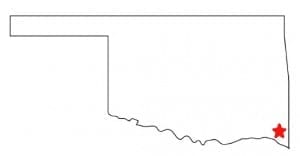
If you are one of these latter histry buffs, consider a visit to Broken Bow and southeast Oklahoma where you can catch a glimpse of “what was” within just a few miles of your vacation cabin. Visit the sites, breathe in the history, and learn a little more about the beginnings of our great state!
America, OK
The Arkansas and Choctaw Railway provided ample opportunity for many a businessman as a means of shipping and receiving. In 1907, William Spencer and his brothers built a sawmill and 40 buildings to house the sawmill employees. This pop-up town that flanked the railway was named “America,” and business thrived while there were ample trees. In time (and when the nearby trees were mostly spent), Spencer changed business tactics and became a cotton buyer, opening a cotton gin and a general store At its height, America was home to 200 residents.
By the end of the 1920s, the town began to decrease production and eventually became another victim of The Great Depression. While some residents remained, the post office and general store eventually closed in the mid 1940s, and the town’s life all but ended.
Located southeast of Broken Bow (ESE of Idabel) in the Ouachita National Forest, the remaining two houses and railroad marker can be found at the junction of D2225 and N4780.
Hochatown, OK
Although there is still a Hochatown, today’s iteration is much more accessible than the original. Unfortunately, to visit the original Hochatown, you will need to don SCUBA gear and dive into Broken Bow Lake!
The original Hochatown started as a Choctaw Indian settlement and became a lumber camp when the Choctaw Lumber and Coal Company moved in. The town was then made up of a commissary, cook shack and a bunkhouse. After the prime timber was exhausted, a farming community was built, and soon after the town became known as the “Moonshine Capital of Oklahoma”. In time, residents moved to more accessible towns with more creature-comforts, and the original town land was covered by what is now Broken Bow Lake when the dam was built.
The only thing that remains from the original Hochatown are the cemetery plots and church that were moved to the modern cemetery along route 259.
McCurtain (Panther), OK
While not a TRUE ghost town (as the town still has residents), McCurtain holds the evidence of a much more prosperous era in its downtown.
Panther was established in 1889 (and renamed McCurtain in 1902) when coal was discovered in the area, and the San Bois Coal Company moved in. Along with nearby Chant, McCurtain grew to prosperity when the Fort Smith and Western Railroad connected the town to Firt Smith, Arkansas in the early 1900s.
The town prospered until 1912 when an explosion in the mine (http://www.rootsweb.ancestry.com/~okleflor/newspapers/1912explosion.htm) killed 73 miners and ruined the coal company. Soon after, McCurtain and Chant became a single town (keeping the McCurtain name), and the population dropped drastically.
Today you can visit the Miners Cemetery where the 73 graves remain. The cemetery is now knows as the Garden of Memories Cemetery and is located on N4510.
